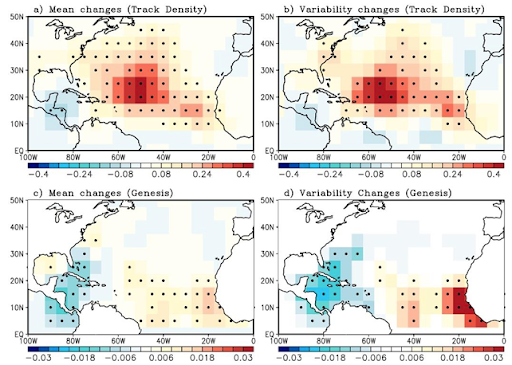Projected increase in the variability of Atlantic tropical cyclone activity
Tropical cyclones are among the most deadly and costly natural disasters that affect the United States and many other countries each year. This has led the scientific community to prioritize improving tropical cyclone prediction and the understanding of how tropical cyclone activity has changed and will change in the future. In a new study published in Science Advances by Lopez et al., NOAA and partner researchers project an increase in the variability of Atlantic tropical cyclone activity, leading to more active and inactive hurricane seasons and less near-normal seasons.
The study investigates how the accumulated cyclone energy (ACE), a measure of seasonal activity, in the North Atlantic might change in the future. Researchers examine why there have been so many active seasons in recent years. The results show that both unusually active and inactive hurricane seasons have become more common since the 1990s, and computer models predict that by the middle of this century, the variability could increase by an additional 36%, with the biggest increase expected to occur in the central tropical North Atlantic, which refers to the mid-section of the North Atlantic Ocean where tropical storms and hurricanes most frequently form.
“The historical year-to-year variability in hurricane seasons is much larger than any projected future trends in hurricane activity,” said Hosmay Lopez, Ph.D., NOAA oceanographer and lead author of the new study. “While the scientific consensus is for a future reduction of 2 storms per year, the number of named storms in the North Atlantic revealed much larger swings between 28 named storms in 2005 and 8 in 2014. Despite these large year-to-year fluctuations, future changes in the interannual variability of hurricane activity are rarely investigated in detail, resulting in significant uncertainty in future projections and impacts. Therefore, there is an urgent need to better understand not only the mean activity changes but also the interannual variability changes.”
The study also found that while the total number of hurricanes in a given season, averaged over many years, should not change much, the likelihood of extremely active seasons will increase due to a projected increase in the year-to-year variations. An amplified variation will increase the number of inactive and active seasons at the expense of a reduction in the near-normal seasons. Note that the seasonal hurricane outlook currently issued by NOAA and others is based on three categories (i.e., above normal, near normal, and below normal seasons).
Larger year-to-year swings between busy and quiet hurricane seasons in the North Atlantic pose significant challenges for forecasters, emergency decision-makers, and communities. The variability from one season to the next makes it more difficult for scientists to predict the severity of any given hurricane season. Additionally, the unpredictability of active vs. inactive seasons creates challenges for disaster preparedness and response since some seasons will be extremely dangerous while others will be relatively quiet. This means that communities in hurricane-prone areas will need to adapt to seasons that have the possibility of being extremely active, like we saw in 2005 and 2020.

Figure 1. Projected changes in how many tropical cyclones occur in each location (top) and where they form (bottom) across the North Atlantic Ocean. The left panels show average changes and the right panels show variability changes. Changes are the difference between future climate model projections from 2020-2049 in relation to the historical period of 1970-2019.
Projected increase in the frequency of extremely active Atlantic hurricane seasons (Science Advances)
Topics
- Extreme Events
- Hurricane
- Atlantic Ocean
